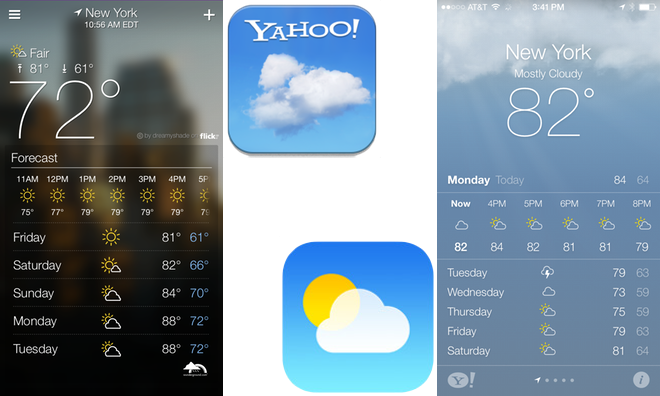The relationship between Apple and Yahoo has seemingly expanded in the development of iOS 7, strengthening the bond that has existed between the two companies since the launch of the first iPhone in 2007.
When the first iPhone debuted, Apple had partnered with two key companies to deliver content to users: Google and Yahoo. Now, in 2013, Google is a chief competitor to Apple and has all but disappeared from the built-in iPhone software, while Yahoo's iOS integration continues to grow.
Reports first surfaced this April indicating that Apple and Yahoo were in talks to deepen integration of Yahoo's services into Apple's iOS platform. And with the reveal of iOS 7 earlier this month, those rumors were seemingly confirmed with two key changes to the mobile operating system: a new Weather application, and built-in support for Yahoo's Flickr photography service.The new Weather application and Flickr integration verify rumors that Apple and Yahoo plan to collaborate on iOS software and services to an even greater degree than before.
The new native Weather app, in particular, demonstrates an apparent behind-the-scenes collaboration between the two companies leading up to the unveiling of iOS 7.
Yahoo's own weather application for iOS, available as a free download on the App Store, was updated in April with a new look. Many of those same design elements — including font choice, icons and layout — can be found in a similar appearance in Apple's new native Weather app in iOS 7.
The commonalities between the two applications indicate that Yahoo had a hand in developing and designing the native Weather application in iOS 7, and is not just supplying weather data to Apple. Yahoo Weather was also recognized by Apple this month in the company's annual design awards, handed out at the 2013 Worldwide Developers Conference.
Though it has a very similar appearance to Apple's software, the Yahoo Weather application is more full-featured, as it offers users the ability to scroll down and view a weather map, precipitation, wind, and even the position of the sun and moon. And while Apple's built-in Weather app features background animations that mimic the current weather conditions, Yahoo's offering instead pulls photos of the appropriate city from its Flickr service.
While Flickr users' photos don't appear in Apple's native Weather application in iOS 7, the first beta build of the new mobile operating system does include built-in support for Yahoo's photo sharing service. When viewing a picture in the native Photos app in iOS 7, users can select the share button and choose Flickr to upload their shots.
Flickr integration in iOS 7 can be enabled in the iOS 7 Settings application, where users can enter their username and password. The photo service now appears alongside Twitter, Facebook and Vimeo
While Yahoo's integration in iOS grows stronger, one major photo sharing option is unsurprisingly absent from iOS 7: Google+. Starting with the removal of Google Maps and YouTube as native options in last year's iOS 6, Apple has been looking to remove traces of Google from its mobile platform, not add them.
iOS 7 even takes the ouster of its rival one step further by replacing Google search in Siri with integrated results provided by Microsoft's Bing. Users can still have Siri search Google — or even Yahoo — through Safari by specifying the service of choice when searching, but general queries will return integrated Bing results by default.Closer cooperation with Yahoo comes as Apple has worked to eliminate Google's presence in its built-in iOS applications.
One aspect where Google remains the default choice, however, is as search provider in Apple's mobile Safari browser. Users can manually change their preferred search service to Yahoo or Bing in the Settings application if they so choose, but Google is still the standard for Safari.
Reports in 2010 claimed that Microsoft and Apple held discussions about potentially making Bing the default search provider in iOS. But Apple has not yet made any moves to cut that tie with Google.
The rift between Google and Apple began to form when Google started pushing its own Android mobile operating system to compete with Apple's iPhone. Late Apple co-founder Steve Jobs felt betrayed by Google, and that the search giant had betrayed an alliance with his own company
Google has responded by aggressively releasing its own third-party applications for iOS, including Google Maps, Google+, Gmail, Google Drive and others. Those applications can even be configured to automatically load websites in the company's own Chrome browser for iOS, bypassing Apple's default Safari browser.


